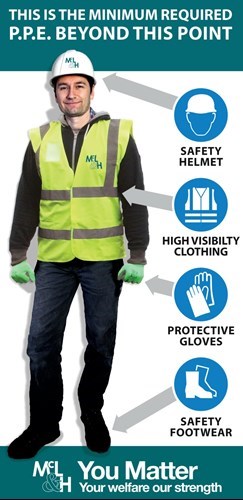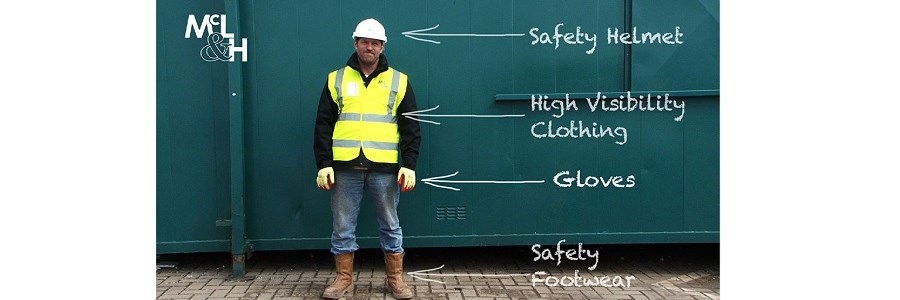
It is a requirement on McLaughlin & Harvey projects that as a minimum all site personnel wear
- Safety footwear with impact resistant toe caps and pierce resistant mid-sole protection to BS EN SO 0345: 2011
- Hard hat to EN 397 standard
- High visibility clothing:
- Class 2 high visibility clothing for construction sites
- Class 3 high visibility clothing for highway works
- Gloves – it is important that gloves selected offer the appropriate protection for the tasks being undertaken. Specific types of gloves to be worn must be explicitly risk assessed
Railway works:
- Rigger boots are not permitted on / near the track
- Orange class 2 high visibility clothing (vests / jackets & trousers) – specific network provisions will apply
Marine engineering contracts:
- All persons on site are required to wear an appropriate personal flotation device when working within 2m of inland or inshore waters.
- Note: Risk assessments may indicate that wearing of PFDs is not appropriate for plant operatives and MEWP users in such locations, but this must be risk assessed on a site by site basis.
Personal fall protection equipment:
- Note: Collective protective measures must be used as a priority over personal fall protection systems.
Personal fall protection equipment is only to be used by competent persons who have successfully completed a recognised training course in the use and maintenance of such equipment.
- Full body harnesses are to be issued to and be for the personal use of individual operatives. Such equipment is not to be `shared round’. Operatives are to ensure that they inspect their equipment prior to use and report defective equipment immediately to their line manager.
- Before the use of such equipment is sanctioned, contractors must provide a work at height emergency rescue plan.
Your employee(s) will also be obliged to wear any other personal protective equipment deemed necessary as a result of your own risk assessment findings e.g. hearing defenders, dust masks and eye protection / goggles. The provision of such personal protective equipment is your responsibility.
Should your employee(s) or those under your control arrive on site without an appropriate item of PPE they will be instructed to leave site until they obtain the necessary item(s).
- Note: All personnel on-site should be appropriately dressed; shirtless personnel will not be permitted on site, nor will shorts or vests.


